A cross stitch thread holder, a seemingly unassuming tool in the world of embroidery, is an essential companion for both novices and seasoned cross stitch enthusiasts. Its purpose is to maintain order amidst the colorful chaos of embroidery floss.
This unobtrusive device plays a crucial role in preserving the integrity of your threads, ensuring they remain tangle-free and readily accessible throughout your creative journey.
In this guide, we will explore the art of using a cross-stitch thread holder, a skill that elevates the cross-stitching experience, allowing you to focus on the art itself rather than wrestling with unruly threads. Let’s unravel the secrets of this indispensable tool.
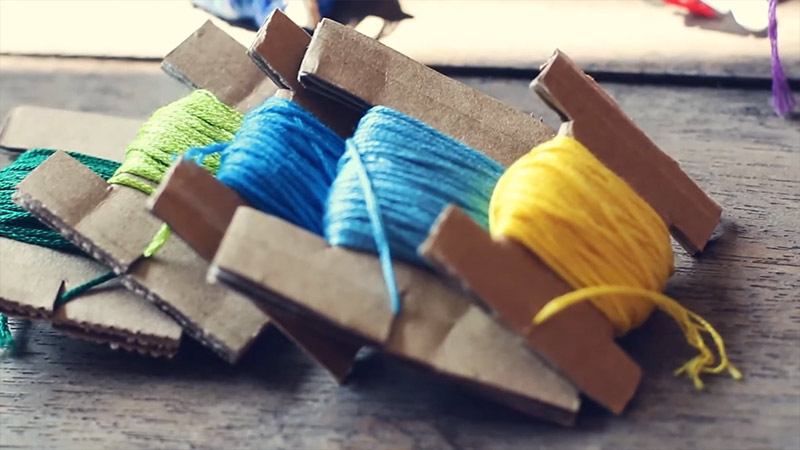
What Is a Thread Holder?
A thread holder, in the context of crafting and embroidery, is a simple yet invaluable tool designed to keep embroidery threads organized and easily accessible.
It typically consists of a compact, often plastic or cardboard, device with compartments or holes for securing individual strands of thread.
Cross-stitch and embroidery enthusiasts use thread holders to prevent tangling and maintain order among various thread colors.
These holders often include features for labeling or numbering compartments, making it easier to identify and select specific thread shades, a crucial aspect of intricate embroidery work.
Thread holders streamline the creative process, ensuring that threads are ready for use, contributing to a smoother, more enjoyable crafting experience.
How Do You Use a Cross Stitch Thread Holder?
A cross stitch thread holder, also known as a floss organizer, is an essential tool for anyone who enjoys cross-stitching.
It helps you keep your embroidery threads organized and prevents them from becoming tangled or messy.
Here’s a step-by-step guide on how to use a cross-stitch thread holder effectively:
1. Gather Your Supplies
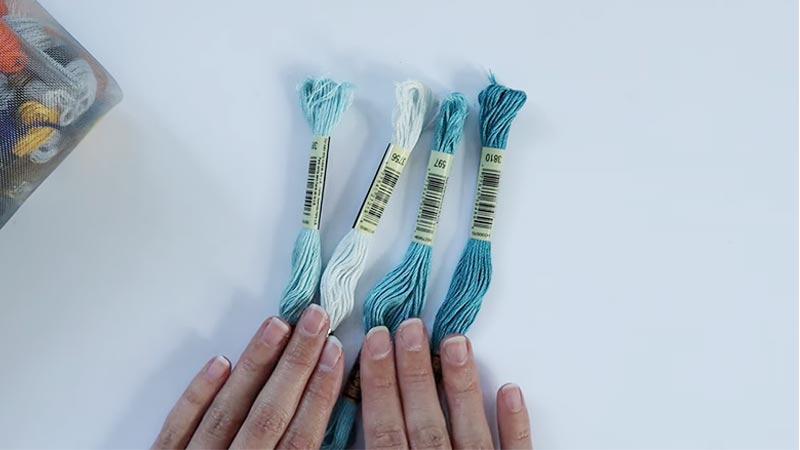
- Cross stitch thread holder
- Embroidery floss or thread
- Scissors
2. Prepare Your Thread
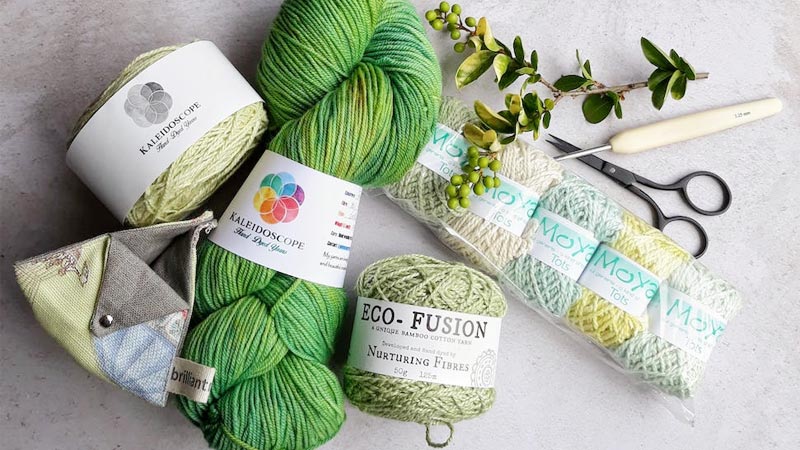
Before you begin using the thread holder, it’s essential to cut the lengths of embroidery floss you’ll require for your project.
Cross-stitch threads typically consist of six strands, but you may choose to use fewer strands based on your pattern or personal preferences. Cut the threads to a manageable length, usually around 18-24 inches.
3. Thread the Holder
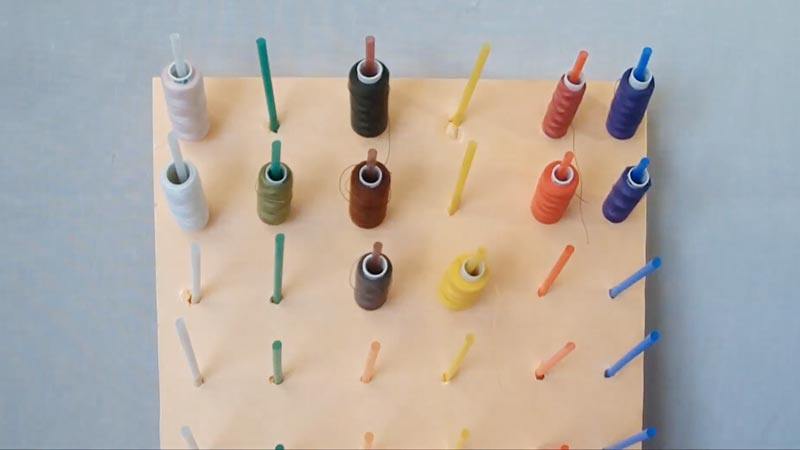
Open the thread holder, which is typically made of plastic or cardboard. It is designed with multiple compartments or holes for storing your threads.
Thread each strand of floss through one of these compartments. You can group threads by color, number, or any system that is convenient for you.
4. Label the Holder
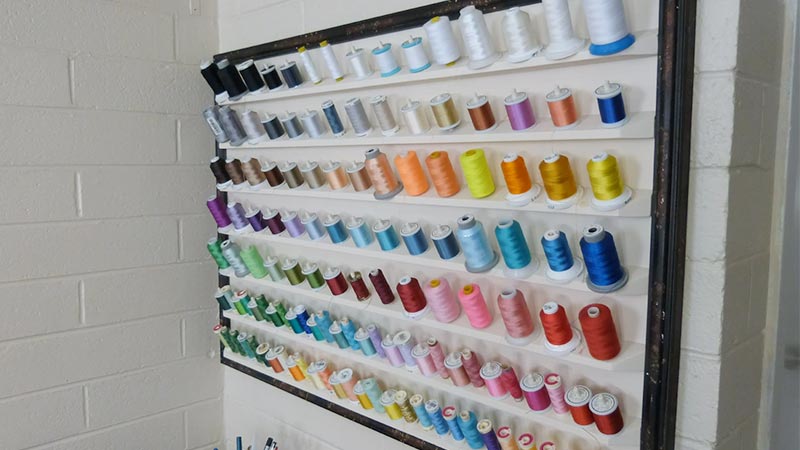
To make it easier to identify the colors, you have the option to label each compartment with the corresponding floss number or color name.
This becomes especially helpful when working on complex cross-stitch patterns with multiple colors.
5. Secure the Ends
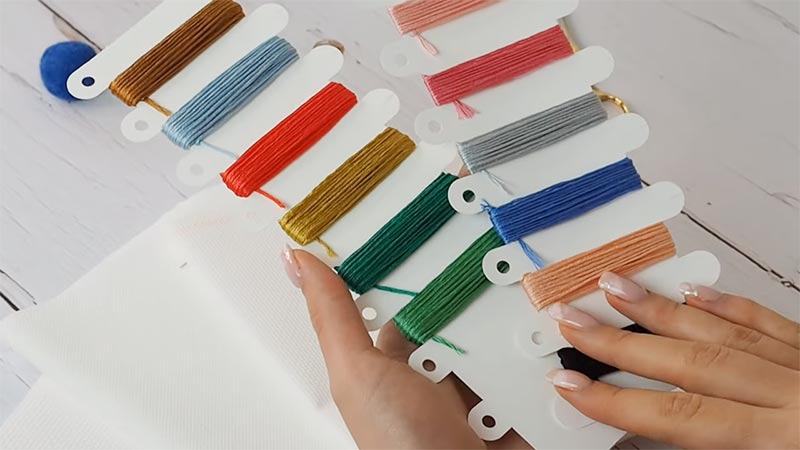
To prevent the threads from slipping out or tangling, you can either tie a knot at the end of each thread or use small plastic bobbins to wind the floss onto.
6. Use and Reorganize
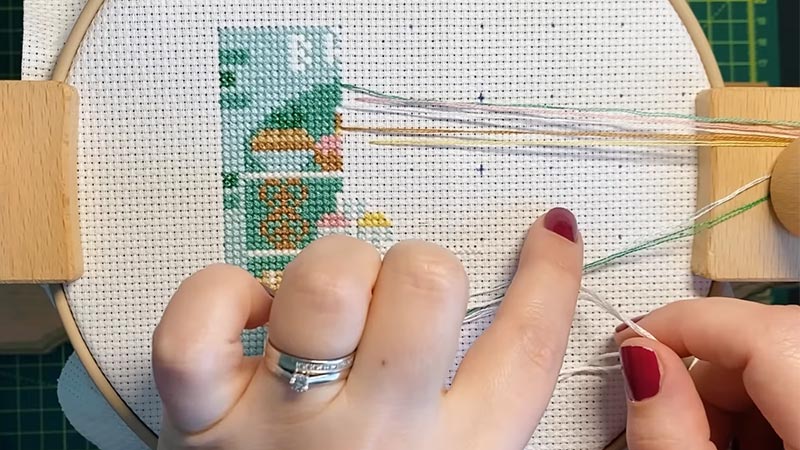
As you work on your cross-stitch project, pull the required strands of floss from the holder. The remaining threads will stay neatly organized and untangled.
When you’ve completed your work with a specific color, simply wind any leftover thread back onto the holder, securing it in its designated compartment. This ensures that your threads are readily available for the next time you need them.
7. Maintenance

Periodically, take a moment to inspect your thread holder. Ensure that the threads are in the correct compartments, not overly tangled and that there’s enough length left for your project.
Benefits of Using a Cross-Stitch Thread Holder
Using a cross stitch thread holder is a practice that offers several benefits for cross stitch enthusiasts and embroidery hobbyists.
Here are the advantages of incorporating a thread holder into your crafting routine:
Organization
One of the primary benefits of a thread holder is the improved organization it provides. It keeps your embroidery threads neatly arranged, preventing them from tangling, knotting, or becoming a chaotic mess. This organization saves you valuable crafting time and minimizes frustration.
Efficiency
With a thread holder, you can easily access the exact color you need for your project without searching through a pile of tangled threads.
This efficiency allows you to focus more on your cross-stitching and less on thread management.
Color Identification
Many thread holders come with compartments that can be labeled or numbered. This feature helps you identify colors quickly and accurately, especially when working on intricate patterns with numerous shades.
Prevents Waste
Using a thread holder minimizes the risk of thread wastage. You can secure leftover threads in their designated compartments, ensuring they remain in good condition for future projects. This economizes your resources and reduces the need to purchase more thread.
Portability
Thread holders are often compact and portable, making them convenient for on-the-go crafting. You can take your threads and holder with you, ensuring that your threads remain organized even when you’re not at your crafting station.
Versatility
Thread holders can be adapted to suit your needs. You can choose from a variety of designs and sizes, from simple plastic cards to more elaborate multi-compartment organizers.
This versatility allows you to customize your thread storage to match your preferences and project requirements.
Enhanced Creativity
An organized workspace and readily available threads can boost your creative flow. You can experiment with different color combinations and confidently tackle intricate patterns, knowing that your threads are neatly arranged and accessible.
Teaching and Sharing
If you’re teaching cross-stitching to others or crafting with friends and family, a thread holder can make it easier for beginners to understand the color-coding system and choose threads for their projects. It’s a valuable tool for sharing your passion for cross-stitching.
Long-Term Thread Preservation
Proper storage in a thread holder protects your embroidery threads from dust, dirt, and damage, preserving their quality for years.
This is essential if you collect threads or plan to work on a project over an extended period.
Reduced Stress
Keeping your threads organized and accessible reduces the stress and frustration that can arise from tangled or misplaced threads.
Crafting should be an enjoyable and relaxing activity, and a thread holder contributes to that experience.
What Can I Do With Leftover Cross Stitch Thread?
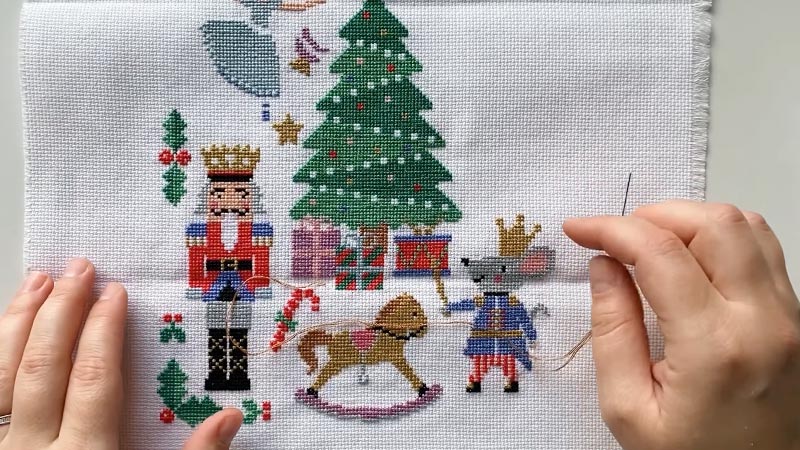
Leftover cross-stitch threads can accumulate as you work on various projects, and it’s essential not to let those precious threads go to waste.
Here are several creative and practical ways to utilize these remnants:
Create Small Projects
Use those extra threads to craft smaller cross-stitch projects, like bookmarks, keychains, or decorative magnets.
These smaller pieces can be completed relatively quickly and make for great gifts or personal keepsakes.
Personalize Clothing or Accessories
Embroider your initials or a small design on your clothing or accessories. For example, add a monogram to your denim jacket, embellish a canvas tote bag with a unique pattern, or stitch a decorative element on a plain beanie.
Mend or Embellish Clothing
When you have a thread that matches the color of your clothes, use it for minor repairs. Reinforce fraying seams or secure loose buttons. Additionally, you can enhance your garments with delicate decorative stitching.
Experiment with New Patterns
Explore new cross-stitch patterns or create your own designs using leftover thread. This experimentation can lead to discovering fresh color combinations and designs that you’ll love.
Donate to Charity
Many charities and schools appreciate donations of craft supplies, including leftover cross-stitch thread.
Your extra thread can help others engage in creative activities, especially when donated to organizations supporting underprivileged or young individuals.
Teach Others
If you’re an experienced cross stitcher, sharing your leftover thread with beginners can encourage them to learn and enjoy the craft. It’s a great way to introduce friends or family to the world of cross-stitching.
Organize and Label
To keep track of your leftover thread, wind them neatly on thread cards or bobbins. Label these cards with the color code, making it easy to identify the thread when you need it for future projects. A well-organized collection can save time and prevent duplicate purchases.
Sell or Trade
If you have an extensive surplus of leftover thread, consider selling it on platforms like Etsy or eBay. You can also trade with other cross stitch enthusiasts through online forums, ensuring that the extra thread finds a new home and purpose.
Experiment with Other Crafts
Your leftover thread can be repurposed in various craft projects. Create friendship bracelets, and earrings, or even experiment with decorative accents in your knitting or crochet projects.
Create a Color Reference
Build a comprehensive color reference chart using small snippets of leftover thread. This reference chart can be an invaluable resource when selecting colors for future cross-stitch projects, ensuring that your thread collection remains organized and accessible.
How to Choose the Perfect Cross-Stitch Thread Organizer?
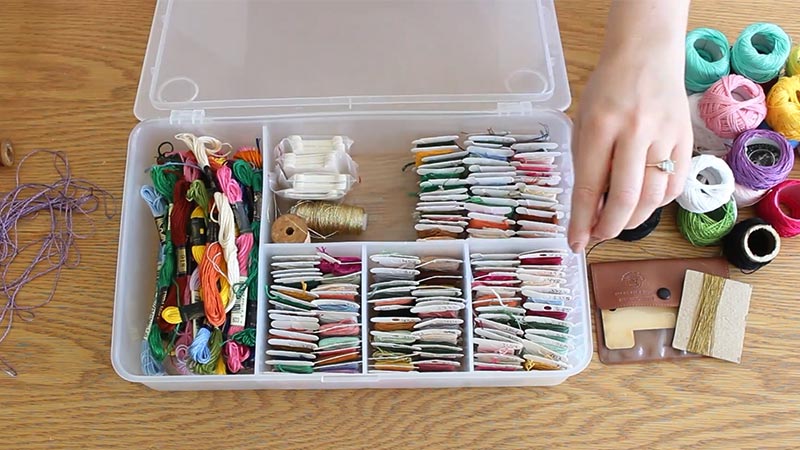
Choosing the perfect cross-stitch thread organizer is essential for keeping your embroidery threads well-managed and your crafting experience enjoyable.
Here’s a guide to help you select the right organizer for your needs:
Consider Your Thread Collection
Assess the size of your thread collection. If you have a substantial number of threads, you may require a larger organizer with numerous compartments. On the other hand, if you’re just starting out, a smaller organizer may suffice.
Material and Durability
Thread organizers are typically made of plastic or cardboard. Plastic organizers tend to be more durable and long-lasting, protecting your threads from environmental factors like dust and moisture. Choose a material that aligns with your storage needs and crafting habits.
Compartment Design
Evaluate the compartment design of the organizer. Some organizers have separate compartments for each thread, while others may have multiple threads sharing a single compartment. The former is better for preventing tangling and keeping your threads separate.
Color-Coding and Labeling
Look for organizers with color-coded or numbered sections. This feature is invaluable for quickly identifying and selecting the correct thread shade for your projects.
Additionally, opt for an organizer that allows you to label or mark the compartments, especially if you have multiple brands or need to specify the thread type.
Portability
If you plan to cross stitch on the go or in different locations, choose a thread organizer that is portable and easy to carry. Compact and lightweight organizers are ideal for crafting away from your primary workspace.
Thread Length Control
Some organizers have features to control the length of your threads, allowing you to cut threads to your preferred length. This can reduce thread wastage and maintain a neat work area.
Versatility
Select an organizer that is versatile and can be adapted to your needs. Some organizers are designed to accommodate both embroidery floss and larger skeins of thread, making them suitable for a wide range of projects.
Organization Goals
Consider how you want to organize your threads. Do you prefer to sort them by color, number, brand, or project? Ensure the organizer you choose aligns with your preferred organizational system.
Budget and Quality
Thread organizers are available in various price ranges. While it’s important to stick to your budget, prioritize quality and durability.
Investing in a higher-quality organizer may save you money in the long run, as it will last longer and better protect your threads.
User Reviews and Recommendations
Read user reviews and seek recommendations from fellow cross-stitchers or crafting communities. This can provide valuable insights into the practicality and effectiveness of specific thread organizers.
Personal Preferences
Ultimately, your choice should align with your personal preferences. Whether you prefer a sleek plastic card-style organizer or a multi-compartment box, choose the one that suits your style and makes your cross-stitching experience more enjoyable.
FAQS
What is Annie’s Keepers Floss Storage?
Annie’s Keepers Floss Storage is a type of organizer designed to store and manage your cross-stitch thread.
It helps keep your threads neat, organized, and easily accessible for your cross-stitching projects.
Can I use Cross Stitch Yarn instead of Thread?
Cross stitch yarn is generally thicker than traditional cross stitch thread and is better suited for larger cross stitch projects.
You can use it if you desire a bolder and more textured appearance, but it may not be suitable for finer details in smaller patterns.
What is a Cross Stitch Fabric Holder?
A cross stitch fabric holder is a frame or hoop used to stretch and hold the fabric taut while you work on your cross stitch project.
It ensures even tension, making your stitching more precise and preventing fabric distortion.
How do I use a Cross Stitch Pattern Holder?
A cross stitch pattern holder is a tool to keep your pattern visible and easy to read while you stitch.
Place your pattern inside the holder, which often includes a magnifier and adjustable stand, to make it convenient to follow your pattern while working on your project.
To Recap
The use of a cross stitch thread holder is a simple yet transformative practice for anyone passionate about cross stitching.
This unassuming tool, designed to keep embroidery threads organized, plays a pivotal role in enhancing the overall stitching experience.
By facilitating efficient organization, preventing tangling, and allowing for easy color identification, it streamlines the creative process.
The benefits extend beyond mere convenience, reducing waste and stress, while also enhancing creativity and project management.
With the aid of a thread holder, cross stitch enthusiasts can immerse themselves in the art without the distractions of messy threads, ensuring that their crafting journey is both efficient and thoroughly enjoyable.
Leave a Reply